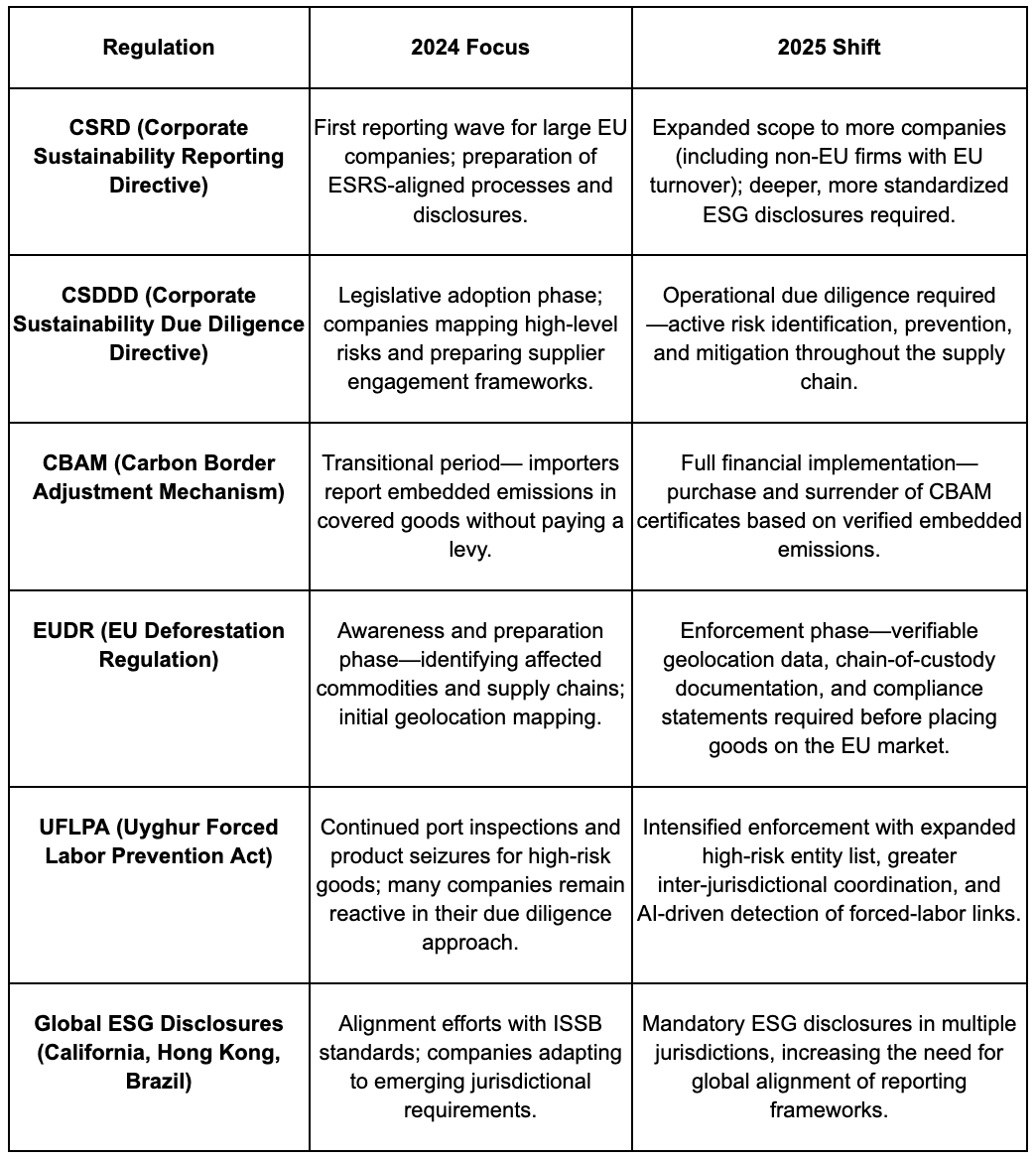5 Compliance Shifts in 2025 Every Company Should Be Tracking
2025 has been the year that various major regulations transitioned from theory to practice. Learn how major developments have reshaped the regulatory compliance landscape.

Article Highlights:
- While 2024 saw many companies focus on preparing for upcoming regulations, 2025 can be described as the year theory became practice.
- In 2024, the Corporate Sustainability Reporting Directive (CSRD) began its first wave of implementation. In 2025, its scope expanded even further—pulling in more mid-sized companies and non-EU firms with substantial EU turnover.
- While supplier compliance programs in 2024 often focused on tier-one audits and contractual clauses, those efforts are insufficient in 2025. Regulations like CSDDD, EUDR, and UFLPA now require companies to trace the origins of their materials several tiers deep.
- In 2025, AI tools are being deployed to scan vast datasets—from shipping manifests to supplier news mentions—to detect signals of forced labor, environmental violations, or ESG controversies.
In 2024, many companies spent their compliance budgets preparing for upcoming regulations, piloting data collection systems, and mapping out supply-chain risks. Compliance was often framed as a “readiness exercise” designed to ensure policies, processes, and reporting templates were in place before deadlines hit.
But 2025 is different. This is the year that theory became practice. Several major ESG and environmental regulations reached full enforcement, including:
- The Corporate Sustainability Reporting Directive (CSRD), which impacted thousands of companies in and outside the EU.
- The first binding phase of the Carbon Border Adjustment Mechanism (CBAM).
- The European Union Deforestation Regulation (EUDR).
The Corporate Sustainability Due Diligence Directive (CSDDD) also took shape, requiring deeper supplier engagement and risk mitigation. Add to that a surge in AI-powered compliance tools, the rollout of Digital Product Passports (DPPs), stronger cross-border enforcement, and rapidly expanding supply-chain transparency requirements, and the compliance environment in 2025 is sharper, faster, and far less forgiving than it was just a year ago.
For organizations that adapt, this evolution is not just a regulatory hurdle. It’s a strategic opportunity to improve operational efficiency, build brand trust, and win competitive advantage in ESG-driven markets. Here are five ways that the compliance landscape—and business’s responsibilities in adapting to it—have evolved in 2025.
1. New and Updated ESG Reporting Rules
CSRD vs. New CSDDD Due Diligence Requirements
In 2024, the Corporate Sustainability Reporting Directive (CSRD) began its first wave of implementation, requiring large EU-based companies to disclose detailed sustainability data under the European Sustainability Reporting Standards (ESRS). In 2025, the scope has expanded further, pulling in more mid-sized companies and non-EU firms with substantial EU turnover.
The Corporate Sustainability Due Diligence Directive (CSDDD) builds on this by adding a legal requirement to identify, prevent, and mitigate negative human rights and environmental impacts within the value chain. While CSRD is about reporting on impacts, CSDDD is about acting on them. For compliance teams, this shifts the focus from data disclosure to operational due diligence, with procurement and supplier engagement becoming core compliance levers.
CBAM: From Transitional to Full Implementation
The Carbon Border Adjustment Mechanism entered its transitional phase in 2024, requiring importers of carbon-intensive goods (like steel, aluminum, cement, and fertilizers) to report embedded emissions without paying the levy. In 2025, the reporting exercise becomes a financial liability: importers must purchase CBAM certificates to offset the carbon footprint of covered goods. This shift makes accuracy, data verification, and supplier cooperation mission-critical, especially for companies sourcing from jurisdictions without equivalent carbon pricing.
EUDR: Tackling Deforestation-Linked Goods
The EU Deforestation Regulation (EUDR) moved into its active enforcement phase in 2025, banning products linked to recent deforestation or forest degradation. The EUDR affects commodities like coffee, cocoa, palm oil, soy, rubber, and wood, as well as derived products such as leather and paper. Compliance demands geolocation data at the plot level, chain-of-custody proof, and risk assessments across complex agricultural supply chains. Compared to 2024’s awareness phase, 2025 requires companies to produce verifiable evidence or risk blocked shipments and significant penalties.
Compared to the groundwork laid in 2024, 2025 marks a decisive pivot from planning to performance. Regulatory bodies are no longer content with policies and preliminary data—they want verified, auditable proof that companies are meeting both reporting and due-diligence obligations.
The table below summarizes how the most impactful ESG and environmental regulations have evolved from 2024’s planning and readiness stage to 2025’s enforcement reality:
ESG and Environmental Regulations: 2024 vs. 2025

These shifts demonstrate that in 2025, compliance teams not only need to collect more granular data, but they also need to verify it at the source, often multiple tiers deep into the supply chain. The result is a greater emphasis on digital traceability tools and supply chain transparency measures.
2. Increased Supply Chain Transparency & Digital Traceability Demands
From Tier-1 Supplier Audits to Multi-Tier Visibility
In 2024, supplier compliance programs often focused on tier-one audits and contractual clauses. In 2025, regulations like CSDDD, EUDR, and UFLPA enforcement make that insufficient. Now, companies must trace the origins of materials several tiers deep—down to farms, mines, and smelters—and maintain a living digital record of every step in the product lifecycle.
Digital Product Passports, Blockchain, and IoT Adoption
Requirements for the Digital Product Passport (DPP) have accelerated in 2025 in sectors like batteries, electronics, and textiles. A DPP holds structured data on a product’s composition, origin, repairability, and recyclability, accessible via a QR code or embedded chip. Combined with blockchain for immutable records and IoT devices for live tracking, companies can move from static compliance reports to dynamic, real-time traceability, improving both regulatory assurance and customer trust.
3. Adoption of AI and Technology for Compliance & Risk Management
AI-Powered Risk Detection for ESG and Human Rights
In 2025, AI tools are being deployed to scan vast datasets—from shipping manifests to supplier news mentions—to detect signals of forced labor, environmental violations, or ESG controversies. These systems can flag potential breaches weeks or months before they appear in public databases, allowing proactive remediation.
Predictive Analytics and Dashboards
Predictive models now forecast where ESG or regulatory breaches are most likely to occur, helping compliance teams prioritize site visits, audits, and supplier engagement. For example, product carbon footprinting (PCF) is becoming more automated, pulling data from bills of materials, supplier inputs, and LCA databases to meet a number of requirements, including:
- CBAM
- CSRD
- ISSB requirements
Interactive dashboards centralize these insights, providing real-time visibility for executives, auditors, and operational teams alike.
4. Greater Enforcement, Penalties, & Global Reach
UFLPA Seizures and Coordinated Enforcement
The U.S. Uyghur Forced Labor Prevention Act (UFLPA) continues to drive product seizures at ports, targeting goods linked to Xinjiang, China. 2025 has seen an increase in intelligence sharing between U.S., EU, and other jurisdictions, making it harder for high-risk goods to slip through undetected.
Beyond the EU: Global Regulatory Shifts
While the EU dominates headlines, other jurisdictions are aligning with global ESG and disclosure frameworks. California’s Climate Corporate Data Accountability Act, Hong Kong’s ESG disclosure mandates, and Brazil’s adoption of ISSB-aligned sustainability standards are broadening the compliance map. For global companies, this means ESG is no longer a “regional” challenge—it’s a universal business requirement.
5. The Need for a Cross-Functional Compliance Ecosystem
Collaboration Between Procurement, Legal, Sustainability, Finance, and IT
Last year saw compliance mostly led by sustainability or legal teams. In 2025, the complexity of ESG regulations has forced a truly cross-functional approach.
- Procurement owns supplier engagement and contract clauses
- Legal ensures regulatory alignment
- Finance manages carbon pricing impacts
- IT integrates traceability systems
- Sustainability ensures the strategy meets corporate ESG goals
Supplier Training and Joint Risk Ownership
Rather than pushing compliance burdens exclusively onto suppliers, leading companies are providing training, capacity-building, and shared tools to improve ESG performance across their value chains. Joint ownership of labor, environmental, and governance risks strengthens resilience while also building long-term relationships between manufacturers and their suppliers.
Practical Implementation Tips
Build Risk-Based Compliance Assessments
- Focus resources where regulatory, reputational, or operational risks are highest — whether that’s high-emission imports, deforestation-linked commodities, or regions with high labor rights risks.
Use Technology Platforms for Visibility, Traceability, and Reporting
- Leverage integrated platforms that consolidate supplier data, automate due diligence workflows, and provide audit-ready reports.
- Linking DPP data with ESG reporting tools ensures consistency and completeness.
Apply ESG Governance Frameworks Aligned with New Mandates
- Frameworks like OECD Due Diligence Guidance, ISSB disclosure standards, and GRI can be harmonized with CSRD and CSDDD requirements, reducing duplication and improving compliance efficiency.
Prepare Audit-Ready Documentation and Dashboards
- Keep geolocation evidence, supplier certifications, emissions data, and remediation records in centralized, searchable systems.
- Dashboards that visualize compliance performance not only support audits but also guide executive decision-making.
Compliance Is a Strategic Advantage in 2025
In many ways, the compliance leap from 2024 to 2025 represents more than a calendar year. It’s a structural shift in how companies operate, report, and compete. Regulations like CSRD, CSDDD, CBAM, and EUDR demand deeper supply-chain engagement, better data, and transparent proof of ESG performance.
From AI risk analytics to Digital Product Passports, technology is actively transforming compliance from a static reporting exercise into a live, dynamic capability. Enforcement is more coordinated, penalties are higher, and global reach is broader.
Companies that embrace cross-functional collaboration, leverage digital traceability, and treat compliance as a source of value rather than a cost will not just survive this new era, they’ll lead it. The best practices for effective compliance in 2025 include continuous adaptation and technology-led transparency. More than that, though, they’re also emerging as critical, winning differentiators.
The Z2Data Solution
Z2Data is a leading supply chain risk management platform that helps organizations identify supply chain risks, build operational resilience, and preserve product continuity.
Powered by a proprietary database of 1B+ components, 1M+ suppliers, and 200K manufacturing sites worldwide, Z2Data delivers real-time, multi-tier visibility into obsolescence/EOL, ESG & trade compliance, geopolitics, and supplier health. It does this by combining human expertise with AI and machine learning capabilities to provide trusted insights teams can act on to tackle threats at every stage of the product lifecycle.
With Z2Data, organizations gain the knowledge they need to act decisively and navigate supply chain challenges with confidence.


.svg)






